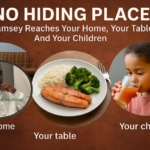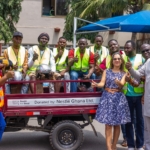
No Hiding Place: Galamsey Reaches Your Home, Your Table, and Your Children
When people hear the word galamsey, many picture a distant forest, a muddy river, or a group of miners crouched over a pan of silt. It feels far away, an issue for rural districts and mining towns, not for city dwellers, ministers in Accra, or families living in gated communities. But galamsey has a way of traveling. Its poison does not respect fences, titles, or postcodes. Even if you have never seen a galamsey pit, you have likely eaten from one, drunk from one, or breathed the dust it left behind.
From Pit to Plate
Mercury from gold amalgamation and arsenic from disturbed soils do not stay put. They wash into rivers, are absorbed by crops such as cassava and plantain, and end up in market stalls in Kumasi, Accra and other parts of the country. In Atiwa East, researchers found cassava with mercury levels above recommended safety limits, and those roots do not just feed the villagers who grew them; they travel in sacks to feed cities.
Fish pulled from polluted rivers, vegetables irrigated with tainted water, and grains grown downstream of mining sites all carry a trace of the chemicals used upstream. And these are not just local delicacies, they become part of school lunches, chop bar menus, and the very meals served at the tables of the ordinary Ghanaians, members of parliaments, ministers, and even the president. The galamsey crisis dines with us all.
Consider this: A family in East Legon sits down for Sunday lunch boiled yam, kontomire stew, and grilled tilapia. They are far from any mining site, yet recent research by Pure Earth and Ghana’s EPA found toxic levels of lead and mercury in fish and vegetables from artisanal mining areas, with some samples showing lead up to 2.8 mg/kg and mercury levels over 130× the safe limit. The tilapia might have come from a polluted river in Central Region, the kontomire grown in Western North where lead in leaves reached 3.1 mg/kg, and the yam from Atiwa East where cassava was found with mercury above international food safety limits. This is how galamsey enters our kitchens silently not as a news headline, but as a meal.
Invisible Dust, Visible Harm
The reach of galamsey is not limited to water and crops. Dust from mine sites travels kilometers on the wind. Airborne particles rich in lead, silica, and other contaminants settle on roofs, in open wells, and on the leaves of crops. Inhaled over time, they can scar lungs, worsen asthma, and carry heavy metals into the bloodstream. Urban areas may be miles away from active galamsey operations, but they are not immune. Contaminated river water is often pumped, treated at great expense, and piped into our homes. And as Ghana Water Company has repeatedly warned, treatment costs are rising sharply costs that are passed to consumers through tariff hikes.
Health Without Borders
Chemical exposure from galamsey is not dramatic like an accident or a flood; it is slow, cumulative, and cruelly democratic. Children in wealthy neighborhoods and poor villages alike may be consuming the same mercury-laced yam or fruits. Chronic exposure can impair brain development, reduce IQ, and raise the risk of kidney disease or cancer. There is no exception, not for judges, not for miners, not for the political class, not for those who think they are far removed from the problem. The contamination we permit eventually finds our tables, our bodies, and our children’s bloodstreams.
The National Mirror, there is no hiding Place
This is why the galamsey debate cannot be reduced to a rural security problem or a “local government issue.” It is a national health emergency. It is also a mirror, reflecting the uncomfortable truth that by tolerating illegal mining, we are tolerating the gradual poisoning of our entire population. There is no hiding place. Not for the galamseyer who drinks from the same stream he pollutes. Not for the policymaker whose family consumes the same cassava he failed to protect. Not for the citizen who looks away and assumes the problem is someone else’s to solve.
A Call to Collective Action
The solution must therefore be collective. Protecting buffer zones around rivers, phasing out mercury, investing in soil and crop testing, and prosecuting financiers of illegal mining are not favors to rural communities, they are measures to protect the whole country. If Ghana does not confront this crisis, the day will come when we look at a sick child or a rising water bill and realize that we were complicit in letting this happen.
Galamsey has already come to our table. The question is whether we will let it stay for dinner or finally show it the door.
The writer, Jonathan Awewomom, is a GH Research Scientist based in Miami, FLorida-USA and a Contributor to National Discourse.




